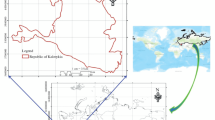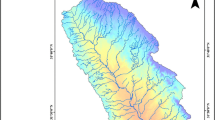Abstract
This article describes general hydrogeological set for the Solani watershed. Satellite imagery obtained from Landsat-7 ETM+ has been analysed to prepare the groundwater prospects map. By using SAR interferometry techniques, paleochannels, geomorphic units, lineaments, could be identified and delineated at a reasonable level of accuracy. In this study the following aspects have been covered: drainage map, geology, geomorphology, depth of water table map, water table contour map, EC (electric conductivity) distribution map etc. From these thematic maps ground water prospects map, has been prepared. As seen in these maps, the depth of water table in this area ranges from 2 m from ground level to more than 100 m; the EC of ground water varies from 284 to 2,000 μS/cm. Five different prospect zones: excellent, good, moderate, low, and runoff zone are identified according to the integration of thematic maps.
Access provided by Autonomous University of Puebla. Download chapter PDF
Similar content being viewed by others
Keywords
Introduction
Groundwater is an important natural resource.
Worldwide, more than two billion people depend on groundwater for their daily supply. A large proportion of the world’s agriculture and irrigation is dependent on groundwater, as are a large number of industries. Surface methods such as remote sensing and morphological analysis provide fast and relatively cheap information, complementary to classical field geology in order to study subsurface geology. Morphological analysis of topographic features, in particular lineaments, has long been applied in structural and tectonic studies and has become a fundamental tool in tectonic analyses using (stereo-) aerial photographs and other remotely sensed imagery.
Study Area
The study area is situated in the foothills of Siwalik; it is located between latitudes 29 ° 47′ 57″ and 30 ° 16′ 16″ N and longitudes 77 ° 44′ 05″ and 78 ° 04′ 26″ E. The area is covered by the rocks of Siwalik Group (upper Siwalik and Middle Siwalik), and Quaternary alluvial. Main Boundary Thrust (MBT) is the important tectonic discontinuity in the area.
Like the rest of the North India the study area is characterized by a sub-tropical rainy climate, essentially because of Himalayan chain and it also experiences four seasons in a year. According to the existing weather condition the study area has been divided into four different seasons: winter season is from December to February, summer season start from March to May, southwest monsoon season is from June to September, post monsoon season is from October to November.
Its average maximum temperature is about 30 °C and the average minimum temperature is around 17 °C. It’s also characterized by an average rainfall around 1,160 mm/annum. Westerly to North-Westerly are the surface wind in winter.
The forest types of study area are mostly moderate to open type and in the upper ridge of Siwalik it is degraded to great extent. The natural vegetation consists of trees, shrubs, and grasses. Taking into consideration the difference in the altitude and the climatic conditions the flora of the watershed may be divided in three main botanical divisions: the moist tropical forests, the tropical dry mixed deciduous forests, and the Siwalik chir forest.
Location map of study area is shown on “Fig. 1”.
Methodology
The methodology adopted in the study consists of the following steps and flow diagram of the study is shown in “Fig. 2”.
Fieldwork
Before fieldwork, satellite data were digitally processed and visually interpreted. Different photo image-elements like tone, texture, and geotechnical elements were taken into consideration for extraction of geological and geomorophological features. Based on landform analysis from satellite images, the pre-field geomorphological map was also prepared.
During the field study, a ground truth was carried out to check the geological and geomorphological interpretations made from satellite imagery. Collection of well inventory data and measuring water table observation of well yield well depth and type of aquifer were done.
Remote Sensing Data Processing and Analysis
Satellite, Radar images, DEM and each derived attribute map can be viewed as raster images and hence be processed using digital image processing procedures to increase the apparent distinction between features in the scenes.
The following image processing methods were used in this study are:
-
1.
Georeferencing and subsequently enhancement of the satellite data such as contrast stretching, filtering, band rationing, color composite, etc., were accomplished with ERDAS IMAGINE software.
-
2.
The reflectance/emittance of any object at different wavelength follows a pattern, which is characteristic of the than object known as “spectral signature”. Proper interpretation of the spectral signature leads to the identification of the object. It is therefore very important to select the images taken in the proper spectral band so that optimum information can be extracted from the images. Landsat-7 ETM+, e.g. from 0.4 to 1.7 μm, in general 0.7–1.3 μm region exhibits high levels of reflectance because of high TR reflectivity of leaves due to their internal cellular structure. 1.3−2.5 μm is characterized by strong absorption by water present in the vegetation and reflectance by the soil.
In this study a DEM is generated by using ERS Fine 1 beam Interferometric SAR. After data fusion was done.
Fused product of ERS1 power and Landsat-7 ETM+ (542) and fused product of Landsat-7 ETM+ (542) and DEM are shown on Fig. 3. DEM can be used as supplement of Remote Sensing data to enhance some features for increasing interpretation accuracy.
The most widely examined and cited geomorphological feature extraction processes from DEM concerns the derivation of hydrological and fluvial features from surface models. The routing of water over the surface of a landscape represents a fundamental geomorphological process that is intimately tied to its form.
Results and Discussion
Analysis of Optical and SAR Data
A drainage map of a basin provides a reliable index of the permeability of the rocks and also gives an indication of the yield of the basin. The study area is sloping down towards southwest from the river from Mohand pass. The runoff water from the rivers, streams of the watershed area drain into the main rivers Solani. Due to moderate to very steep slope in Siwalik hill the drainage is excessive to well drain in piedmont area and well to poorly drain in alluvial plain.
Three lithologic units were mapped from the processed images which are Alluvium, upper Siwalik, and middle Siwalik. Geologically, the study area comprises the rocks of great antiquity (ranging from Neoproterozoic to Recent), belonging to Lesser Himalayan Range, Outer Himalayan Range and Indo-Gangetic Plain. A brief description is given below, and is mainly taken from A.K. Pachauri (1980), K.S. Valdiya (1988).
Delineation of Paleochannels and Some Perennial Rivers from In-SAR Data
Geological interpretation of radar image is based on the analysis of surface morphology, landforms and specific surface elements (dielectric property of materiel, surface roughness, and structures…).
The extraction of geomorphology, geological structure and lithology from radar imagery can be possible because of the higher sensitivity of radar to the surface geometry and surface roughness.
Drainage pattern can be delineated very clearly. The differentiated between perennial and paleochannels can be possible from simulated VV-polarized C-band SAR.
The identification of linear features is possible from radar image which expressed that the most of these features are perpendicular to sub-perpendicular to the look direction (strong return backscattering).
Hydro-Geomorphology
Three different hydrogeomorphological units were identified according to the basic lithology, drainage geomorphology and aquifer characteristics which are: Runoff zone, Recharge zone, Discharge zone.
Runoff zone generally characterizes the areas which have a very high altitude, steep slope, and high drainage pattern. The dissected structural hill is considered as the main runoff zone of the study area. The main litho units which characterize this zone are Upper Siwalik and middle Siwalik rocks.
Recharge zone is the gentle slope, dry streams and the course materiel of boulder and gravels are the main characteristics of this recharge zone. The Upper Piedmont zone is considered as the mainly recharge zone in the study area.
Discharge zone is generally composed with a finer sediments as well as sand, silt, and clay layers. It is characterized by the shallow water level and flowing streams. The mainly discharge zone which characterize the study area is the lower piedmont zone.
Characteristic of Aquifer
The collected data during field work show that the most of these dug wells and tube wells are used for drinking and irrigation purpose; however some dug wells are unused and require cleaning.
The depth to water table map and water table contour map are prepared based on data collected from field work. As seen in these maps, the depth to water table in this area ranges from 2 m from ground level to more than 100 m. On the basis of water table map and ground truth checking, it is observed that the water table is very deep from the ground level in the NE part of study area. In the entire area the groundwater flows towards south where the water table ranges from 240 to around 300 m.
The groundwater prospect map is prepared based on the hydrogeomorphology, lithology, and depth of water table. They are shown on “Fig. 4”.
And final Ground Water Prospect Map is shown on Fig. 5.
Conclusions
The interpretation of Landsat-7 ETM+, radar data and analysis of digital models, together with field studies has made it possible to delineate and map geomorphic units, drainage pattern and tectonic features.
In-SAR data can be used for geological interpretation in terms of morphology, materials and structure recognition, in an acceptable level, particularly when some other data are not available.
Based on the present work, we can identify that the study area is formed by four geomorphic units: Highly dissected structural hill, moderately dissected structural hill, upper piedmont, and finally lower piedmont.
Based on hydrogeomorphological map, the study area is divided in three principal zones: runoff zone characterized structural hills units, recharge zone mainly occur in the upper piedmont and discharge zone mostly in lower piedmont of the area.
As seen in depth to water table map and water table contour map we can observe that the ground water level is deep around 100 m to shallow 3 m respectively from N to the S and the groundwater flow is from northeast to southeast.
The EC value collected from the field and the EC contribution map indicate that the most of ground water in the area is potable.
By integration of geomorphological, lithological, depth to water table map the groundwater map has been prepared which indicate five different prospect zones: excellent, good, moderate, low, and runoff zone.
Author information
Authors and Affiliations
Corresponding author
Editor information
Editors and Affiliations
Rights and permissions
Copyright information
© 2013 Springer-Verlag Berlin Heidelberg
About this chapter
Cite this chapter
Bennia, A., Srivastav, S.K., Chatterjee, R.S. (2013). Groundwater Investigations Using Optical and Microwave Remote Sensing Data in Solani Watershed, India. In: Margottini, C., Canuti, P., Sassa, K. (eds) Landslide Science and Practice. Springer, Berlin, Heidelberg. https://doi.org/10.1007/978-3-642-31445-2_12
Download citation
DOI: https://doi.org/10.1007/978-3-642-31445-2_12
Published:
Publisher Name: Springer, Berlin, Heidelberg
Print ISBN: 978-3-642-31444-5
Online ISBN: 978-3-642-31445-2
eBook Packages: Earth and Environmental ScienceEarth and Environmental Science (R0)









